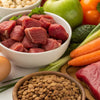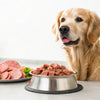How Do You Make Raw Dog Food at Home? A Comprehensive Guide for Pet Owners
- Houndsy
Table of Contents
- Introduction
- Understanding Raw Dog Food
- How to Transition Your Dog to a Raw Food Diet
- Key Ingredients for Homemade Raw Dog Food
- Basic Formulation for Raw Dog Food
- Safety Considerations
- FAQs About Making Raw Dog Food at Home
- Conclusion
Introduction
As pet owners who adore our furry companions, we often find ourselves questioning the best way to meet their nutritional needs. Did you know that a raw food diet can significantly improve your dog's health? Studies have shown that dogs on raw diets have healthier coats, reduced allergy symptoms, and better dental health. With this in mind, we at Houndsy are here to empower you with the knowledge you need to embark on the rewarding journey of making raw dog food at home.
In this post, we’ll dive deep into the essentials of preparing raw dog food, why it’s beneficial for your pet, and how to do it safely and effectively. By the end of this article, you will feel confident in crafting balanced meals that can enhance your dog’s well-being while ensuring they enjoy every bite.
Let’s explore the world of homemade raw dog food together!
Understanding Raw Dog Food
What is Raw Dog Food?
Raw dog food consists of uncooked meat, bones, fruits, vegetables, and organ meats. This diet is based on the premise that dogs are naturally carnivorous animals that thrive on a diet similar to what their wolf ancestors would have consumed in the wild. A raw food diet is often referred to as a "BARF" diet, which stands for "Biologically Appropriate Raw Food" or "Bones and Raw Food."
The Benefits of Raw Dog Food
There are numerous advantages to feeding your dog a raw food diet. Here are some key benefits we must highlight:
-
Improved Digestion: Raw food diets are easier for dogs to digest compared to processed kibble, leading to smaller, firmer stools.
-
Healthier Skin and Coat: The high protein content and healthy fats found in raw meats support skin health and promote a shiny coat.
-
Better Dental Health: Chewing on raw bones helps clean teeth and reduce plaque buildup.
-
Increased Energy Levels: Dogs on raw diets tend to exhibit higher energy levels and better overall vitality.
-
Weight Management: Raw feeding allows for greater control over calorie intake, making it easier to manage weight.
How to Transition Your Dog to a Raw Food Diet
Before jumping straight into the kitchen, it’s essential to understand the proper process to transition your dog to a raw food diet. Suddenly switching your dog's food can lead to digestive upset. Therefore, we recommend a gradual transition over a week or two, mixing raw food with their current kibble.
- Days 1-3: Mix 25% raw food with 75% kibble.
- Days 4-6: Mix 50% raw food with 50% kibble.
- Days 7-10: Mix 75% raw food with 25% kibble.
- Day 11 Onwards: Feed 100% raw food.
By following this gradual approach, your dog’s digestive system can adjust nicely to the new diet.
Key Ingredients for Homemade Raw Dog Food
When making raw dog food, it’s crucial to include a balance of ingredients that can cater to your dog's nutritional requirements.
Meat
Meat is the foundation of a raw dog food diet, providing essential proteins and nutrients. Effective sources of meat include:
- Beef: Provides protein and essential minerals.
- Chicken: Offers various cuts including thighs, liver, and necks.
- Turkey: High in protein and fat, turkey is a great option.
- Lamb: A great source of protein, fat, and micronutrients.
Bones
Raw bones are essential as they provide calcium and aid in dental health. Here are recommended types:
- Meaty Bones: Chicken necks or thighs contain bone and meat.
- Raw Pork Bones: High in calcium and will keep your dog entertained.
- Fish Bones: If safely prepared, fish bones from fresh fish can be nutritious.
Organ Meat
Often overlooked, organ meats are nutrient powerhouses. They represent critical elements in a balanced diet. Important organs include:
- Liver: Rich in vitamins A, D, E, and K, essential for dog health.
- Heart: A good source of taurine, vital for heart health.
- Kidney: Packed with nutrients, kidney meat can be beneficial in moderation.
Vegetables and Fruits
While dogs primarily thrive on meat, adding vegetables and fruits can contribute valuable vitamins and minerals. Consider the following:
- Carrots: Great for eye health and full of fiber.
- Spinach: Provides iron and a range of vitamins.
- Blueberries: High in antioxidants and vitamins.
- Broccoli: Rich in fiber and aids digestion.
Supplements
While most of the nutrition can be provided through raw ingredients, sometimes supplementation is beneficial, particularly if your dog has specific health needs. Options include:
- Fish Oil: For omega-3 fatty acids that enhance skin and coat health.
- Calcium Powder: If you're not feeding enough bone in the raw meats, this can help balance the calcium levels.
Basic Formulation for Raw Dog Food
Creating a well-balanced raw food diet involves knowing the rough ratios of the ingredients. A commonly recommended guideline is:
- 70–80% Muscle Meat
- 10–15% Organ Meat
- 10–15% Raw Meaty Bones
This flexible ratio can vary slightly based on the individual dog’s needs, age, and activity level. Let’s break this down further.
Sample Recipe
To get started, here is a simple recipe designed for a balanced meal, making about a week's worth of food for a medium-sized dog:
Ingredients:
- 3 lbs chicken (with bones)
- 2 lbs ground beef
- 1 lb beef liver
- 1 lb carrots (finely chopped)
- 1 cup blueberries
- 2 eggs (optional for added protein)
Instructions:
- Prepare the Ingredients: Chop the chicken, ground beef, and liver into bite-sized portions. Finely chop or puree the carrots and blueberries.
- Mix Everything Together: In a large mixing bowl, combine the chicken, ground beef, organ meat, vegetables, and eggs (if using). Ensure all ingredients are well mixed.
- Portion and Store: Divide the mixture into meal-sized portions in airtight containers and store in the freezer. Thaw portions overnight in the refrigerator before serving.
Safety Considerations
While raw feeding can offer numerous benefits, it's vital to ensure that food preparation is done safely to avoid harmful bacteria.
- Hygiene: Always wash your hands and utensils thoroughly after handling raw meat. Keeping your preparation area sanitized is crucial.
- Supervision during Feeding: Always supervise your dog while they are eating raw bones to prevent choking or swallowing large fragments.
- Gradual Transition: As mentioned, ensure you transition your dog gradually to prevent digestive upset.
FAQs About Making Raw Dog Food at Home
What if my dog doesn't like the raw food?
Dogs can be picky eaters. If your dog struggles with the transition, try mixing a little of their favorite treat or some bone broth into the raw meals to entice them.
Is raw food safe for all dogs?
Raw food can be safe for most dogs, but if your pet has health conditions or is older, it's best to consult with your veterinarian before starting a raw diet.
How do I store homemade raw dog food?
It’s best to store raw dog food in the freezer in individual portions. Ensure you store the meals in airtight containers to maintain freshness.
Can I mix raw food with commercial kibble?
While some dog owners do this, most nutritionists recommend choosing one diet and sticking with it for optimal health and digestion.
What are the costs associated with making raw dog food at home?
Costs can vary based on the quality of ingredients you choose. However, many pet owners find that making their raw dog food can save them money in the long run when compared to premium commercial diets.
Conclusion
Making raw dog food at home serves as a rewarding way to take control of your dog's nutritional needs, optimizing their health and happiness. We’ve explored the benefits of a raw diet, provided practical guidance on how to create balanced meals, and shared tips to ease your dog into this nourishing lifestyle.
Remember that transitioning to a raw diet is an investment in your dog's health that can yield significant rewards. As we simplify and elevate our feeding routines, let’s not forget to make these moments enjoyable. Each meal can become a shared experience that strengthens the bond between you and your furry friend.
For those of us who desire convenience too, consider pairing your raw feeding practice with our Houndsy Kibble Dispenser. With its ergonomic design, perfect portion control, and beautiful aesthetics, it’s an excellent addition to your pet care routine. Explore our Houndsy Kibble Dispenser here and elevate your dog's feeding experience even further!
FAQ Section
-
What is the best source of protein for a raw dog food diet? Beef, chicken, lamb, and turkey are all excellent protein sources for dogs.
-
How much raw food should I feed my dog? A good rule of thumb is to feed 2–3% of your dog's ideal body weight in raw food daily.
-
Can I prepare raw dog food in advance? Absolutely! Preparing batches in advance is efficient and can save time during the week.
-
Is it normal for dogs to initially resist raw food? Yes, some dogs might take time to adjust. A gradual transition can help ease them into their new diet.
-
Can I consult my vet about raw feeding? Definitely! Your vet can provide guidance tailored to your dog’s specific health needs and dietary requirements.













